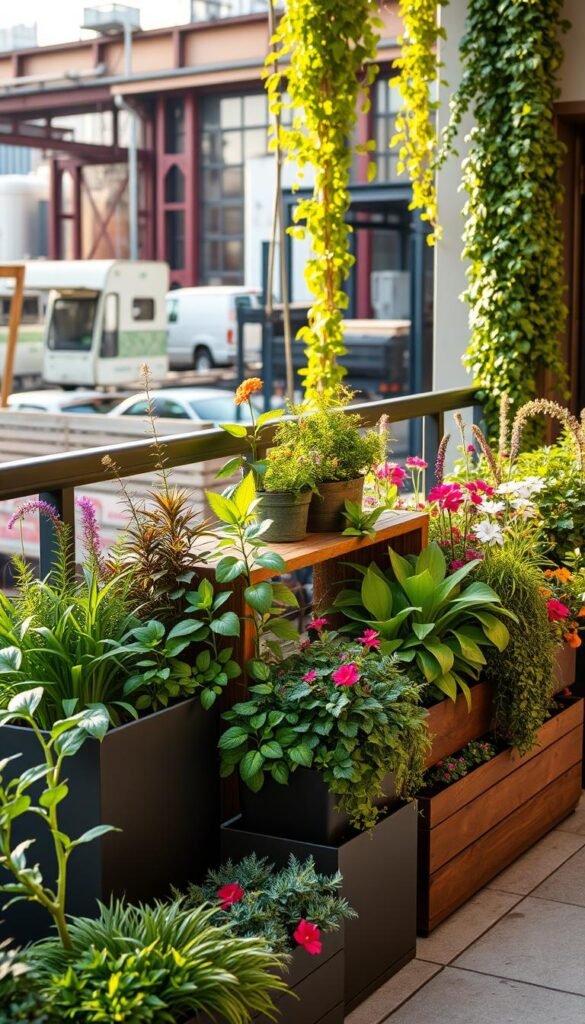Imagine transforming your balcony, rooftop, or even a sunny windowsill into a lush retreat bursting with fresh herbs, vibrant flowers, and homegrown veggies. Limited square footage doesn’t have to limit your green ambitions. With creative solutions, even the tiniest areas can become productive ecosystems.
City living often means adapting to unconventional spaces. Whether you’re working with a fire escape or a narrow alley, portable planters let you grow food and flowers without battling pests like rabbits or deer. A simple step-by-step starter guide reveals how a 12-inch pot can supply enough basil for weekly pasta nights. Herbs like thyme and oregano thrive in tight spots, while compact tomato varieties flourish in deeper containers.
Organic potting mixes make a surprising difference. Studies show they boost yields by 30% compared to synthetic options. Skip discount dirt bags—opt for blends with compost and perlite to nourish roots. Smart choices like dwarf kale or patio strawberries maximize every inch, proving you don’t need acres to enjoy nature’s bounty.
This approach isn’t just practical—it’s liberating. Move plants to chase sunlight or shield them from storms. Refresh your setup seasonally, experimenting with colors and textures. Your tiny oasis becomes a living canvas, blending beauty and function right outside your door.
Understanding the Basics of Urban Container Gardening
Growing fresh food and flowers becomes surprisingly simple when you break free from traditional plots. Elevated planters and portable pots let you bypass common obstacles while adding life to concrete landscapes.
Benefits of Gardening in Small Spaces
Containers turn impossible growing conditions into opportunities. Rocky soil? No yard access? No problem. A single pot with nutrient-rich mix lets you grow juicy tomatoes or fragrant basil anywhere. For those with limited mobility, raised setups mean less bending and more enjoyment.
Pests become less troublesome too. Groundhogs can’t raid peppers growing on your balcony railing. You’ll also gain control over sunlight exposure—slide pots to follow summer rays or shield delicate colorful blooms during heatwaves.
Key Challenges and Solutions
Urban growers often face three main hurdles. Poor native soil limits root growth, but quality potting mixes fix this. Rental rules might ban digging, yet containers keep gardens temporary. Limited space? Vertical planters add growing room without floor footprint.
| Challenge | Solution | Result |
|---|---|---|
| Hard clay soil | Custom potting blends | Healthier roots |
| Deer invasions | Elevated planters | Full harvests |
| Mobility limits | Waist-high tables | Pain-free tending |
Your plant choices matter too. Dwarf fruit trees and bush beans thrive in confined areas. Rotate crops seasonally—swap spring lettuce for fall chrysanthemums. With smart planning, even a 2’x2’ corner feeds your passion for growth.
Preparing Your Space for a Container Garden
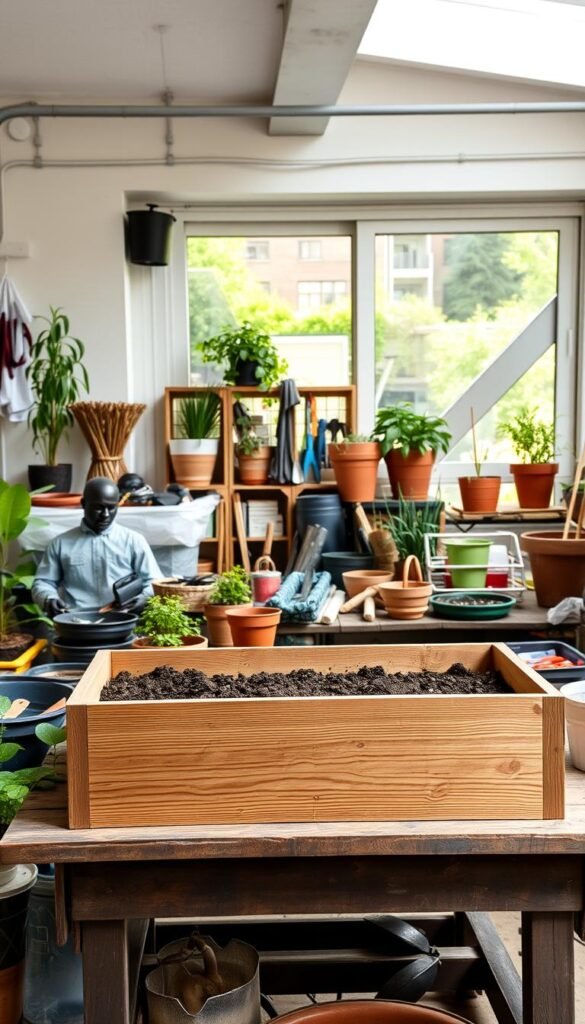
Your journey to fresh greens and blossoms begins with smart planning. Before grabbing pots or seeds, take time to study your environment. This ensures your plants get the best start possible.
Assessing Your Outdoor Area
Start by measuring available spots. Even narrow balconies or fire escapes can host thriving plants. Observe how sunlight moves across your space through the day. Use a free app like Sun Seeker to track patterns.
Note permanent structures like walls or railings. These create microclimates—south-facing surfaces absorb heat, while shaded corners stay cooler. A one-day DIY container setup works perfectly for renters needing flexible arrangements.
Light, Wind, and Location Considerations
Tomatoes and peppers demand six hours of direct sun. Leafy greens manage with three. Place sun-lovers where light lasts longest. Rotate pots weekly for even growth.
Wind dries soil faster and stresses plants. Shield containers with lattice panels or tall furniture. Avoid placing delicate herbs in exposed rooftop corners. Group pots to create natural windbreaks.
Test different zones in your home. A west-facing windowsill might outperform a windy patio. With thoughtful placement, you’ll turn challenging areas into productive spaces.
Selecting the Perfect Containers for Your Garden
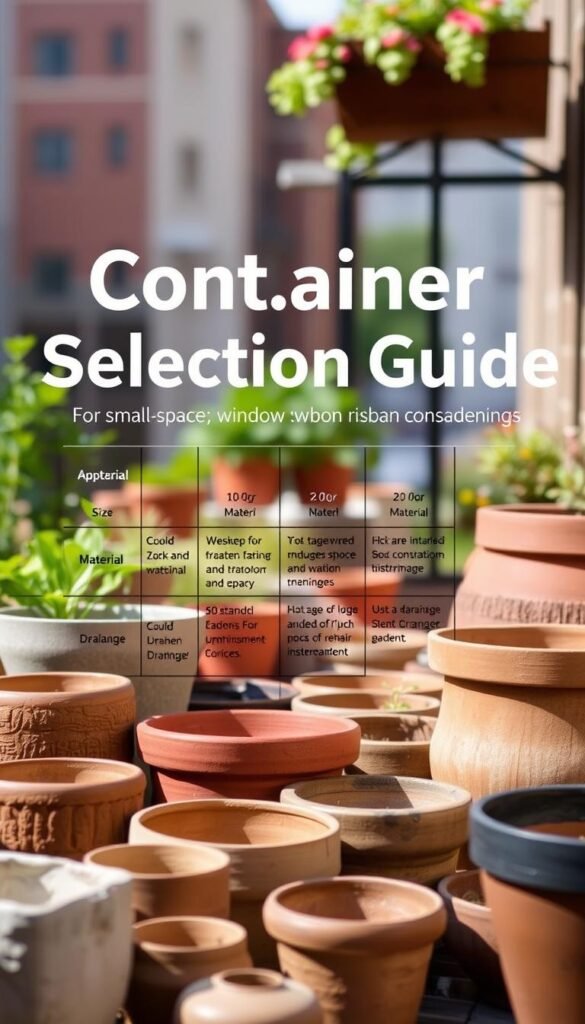
Your container choices shape your garden’s success more than you might think. The right pots or planters balance practicality with style while giving roots room to thrive. Let’s explore how to pick vessels that work with your space, not against it.
Choosing Between Pots, Planters, and Window Boxes
Size matters most. Larger containers hold moisture longer—a 16-inch pot might need watering every 3 days instead of daily. For balcony safety, lightweight fiberglass planters offer durability without excess weight. Window boxes shine for herbs or flowers, but ensure they’re securely mounted.
Material pros and cons:
- Plastic: Affordable and light, but may fade
- Ceramic: Stylish yet heavy—ideal for permanent spots
- Fabric: Promotes air flow but dries faster
Tips on Using Self-Watering Options
Self-watering systems are game-changers for busy growers. Their reservoirs supply moisture for 5-7 days, preventing common watering mistakes. Look for models with overflow drains to prevent root rot. Pair them with moisture-loving plants like mint or lettuce for best results.
Remember: Deeper containers suit tomatoes and carrots, while shallow bowls work for succulents. Match your picks to your plants’ needs, and you’ll see happier growth all season.
Soil and Potting Mix: Getting It Right
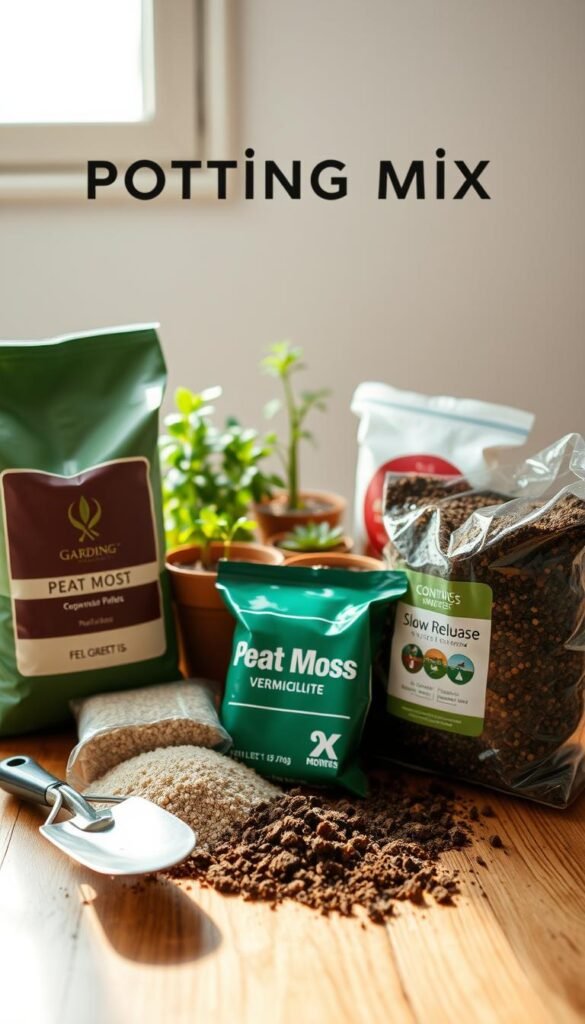
The secret to thriving container plants starts beneath the surface. What you fill your pots with determines whether roots drown in mud or dance in ideal growing conditions. Let’s dig into the dirt on dirt.
Why a Soilleless Potting Mix Works Best
Garden soil and bagged topsoil spell trouble in containers. They compact like concrete after a few waterings, choking roots and blocking drainage. Soilless potting mixes solve this with lightweight ingredients that stay fluffy for months.
Premium blends combine three power players:
- Perlite: White volcanic pellets that create air pockets
- Vermiculite: Gold mineral flakes that hold moisture
- Peat moss: Spongy organic matter that gives structure
These components work like a dream team. The mix drains quickly yet keeps roots hydrated—no more daily watering marathons. Brands like Miracle-Gro add slow-release fertilizer that feeds plants for six months. One gardener shared: “My basil tripled in size after switching to quality potting soil—it’s like steroids for plants!”
Want to boost your mix? Stir in compost for extra nutrients or granular fertilizer for heavy feeders like tomatoes. Remember: Your plants’ home should be cozy, not cramped. Give them the right foundation, and they’ll return the favor with explosive growth.
Watering and Fertilizing Practices for Urban Gardens
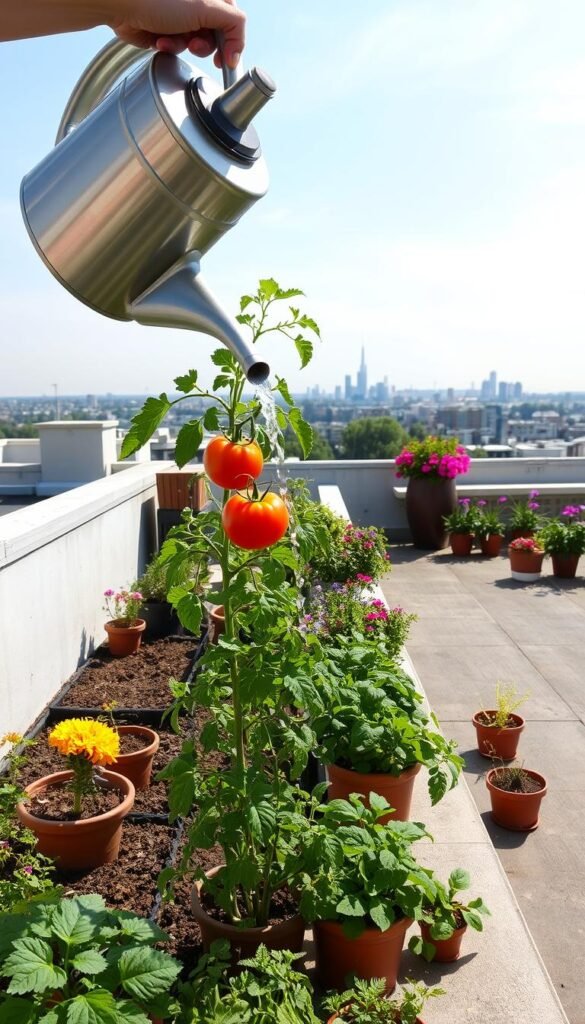
Keeping your green friends happy requires smart hydration and nutrition strategies. Let’s explore how to balance these elements for thriving results.
Efficient Watering Techniques for Consistent Moisture
Plants in pots dry out faster than those in ground soil. Check moisture daily by sticking your finger 2 inches deep. If it feels dry, give a thorough soak until water drains from the bottom.
Morning watering reduces evaporation and prevents fungal issues. During heatwaves, water twice daily—once at dawn and again at dusk. Group pots together to create a humid microclimate that slows drying.
| Technique | Benefit | Best For |
|---|---|---|
| Finger test | Prevents overwatering | All container types |
| Drip irrigation | Saves time | Large plant collections |
| Self-watering pots | Maintains consistency | Frequent travelers |
Organic Fertilizer Advice for Containers
Nutrients wash away quickly in confined spaces. Feed every 2-3 weeks with compost tea or liquid seaweed. These gentle options release nutrients slowly without shocking roots.
Granular organic fertilizers work well too. Mix them into soil at planting time, then top-dress monthly. One gardener swears: “My tomatoes doubled their yield after switching to fish emulsion—it’s like plant protein shakes!”
Always water before applying fertilizers to prevent root burn. Pair these methods with consistent hydration, and your plants will reward you with vibrant growth all season.
Small-Space Urban Gardening: Container and Window Box Essentials
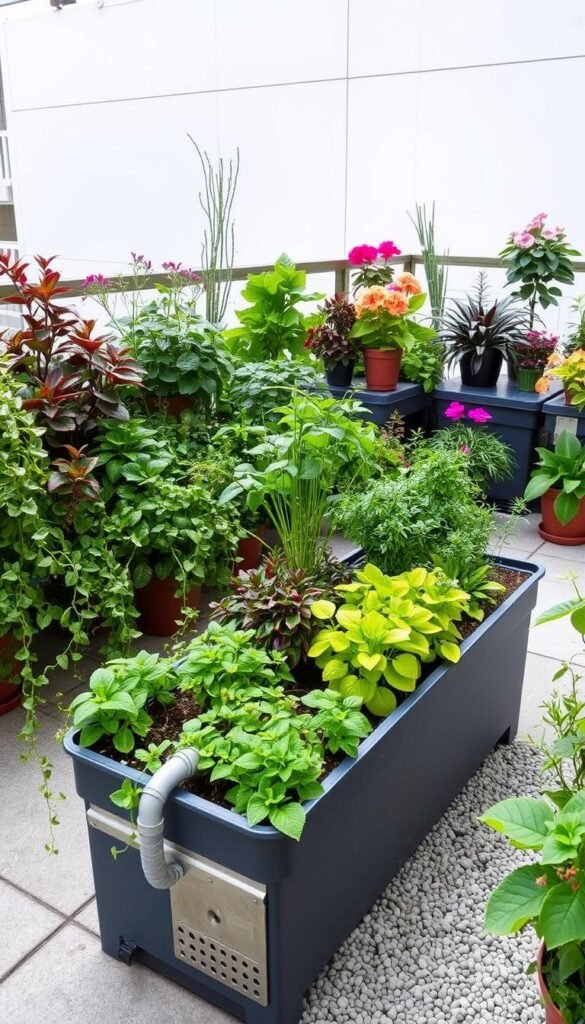
Mastering a few key techniques can turn cramped areas into thriving green spaces. Whether you’re arranging pots on a fire escape or hanging planters indoors, success starts with understanding essential growing fundamentals.
Core Principles and Must-Have Tips
Drainage isn’t optional—it’s your garden’s lifeline. Always choose containers with multiple holes at the bottom. Layer gravel or broken pottery shards beneath soil to prevent waterlogging. One gardener shared: “My mint plants stopped drowning once I added extra drainage—they’re now overflowing their pots!”
Get creative with vertical arrangements. Wall-mounted planters or tiered stands let you grow upwards instead of outwards. Pair trailing plants like ivy with upright herbs for dynamic displays. Check out our guide to the best vegetables for compact setups to maximize yields.
| Principle | Practical Application | Key Benefit |
|---|---|---|
| Drainage First | Use pots with holes + gravel base | Prevents root rot |
| Vertical Growth | Install wall planters or shelves | Triples growing space |
| Seasonal Timing | Start cool-weather crops in early spring | Extends harvests |
| Soil Refresh | Replace potting mix annually | Boosts plant health |
Timing matters as much as technique. Sow fast-growing radishes between slower tomato plants. When one crop finishes, immediately replant with seasonal successors. This continuous cycle keeps your garden productive through frost dates and heat waves.
These strategies form your gardening playbook. Adapt them to your unique space and watch your plants flourish—no sprawling yard required.
Planning Your Planting: Choosing Vegetables and Flowers
Picking the right greens and blooms transforms tight spots into productive plots. Match your selections to container depths and sunlight availability for nonstop color and harvests.
Best Plants for Small-Space Growth
Soil depth dictates your options. Shallow 4-5″ pots suit lettuce and basil, while 12″ containers handle potatoes and squash. Use this cheat sheet:
| Container Depth | Top Performers | Yield Boosters |
|---|---|---|
| 4-5 inches | Radishes, chives | Quick harvests |
| 8-9 inches | Peppers, spinach | Continuous picking |
| 10-12 inches | Eggplants, beans | Heavy producers |
Cherry tomatoes and dwarf kale thrive in most setups. Pair them with marigolds to deter pests naturally. One gardener noted: “Nasturtiums add peppery flavor to salads while protecting my peppers from aphids!”
Rotate crops every 60-90 days. Follow spring peas with fall chrysanthemums. This keeps your garden lively and productive through seasons. Herbs like thyme work as edible ground cover beneath taller plants.
Remember: Mix textures and colors. Purple basil beside yellow pansies creates eye-catching displays. With smart pairings, your space becomes both pantry and art gallery.
Optimizing Your Garden Layout with Window Boxes
Elevate your home’s curb appeal while growing fresh produce with strategic designs. Window boxes offer vertical growing space that blends beauty and function. Start by mastering the “thriller, filler, spiller” formula—a design rule that creates dynamic displays.
Creative Arrangements for Maximum Impact
Choose a bold centerpiece plant (thriller) like purple fountain grass. Surround it with mid-height flowers (filler) such as petunias. Finish with trailing varieties (spiller) like sweet potato vine for cascading drama. Rotate these elements seasonally for year-round visual interest.
Companion Planting and Plant Combinations
Pair plants that support each other’s growth. Tomatoes thrive beside basil and onions, while beans enrich soil for carrots. Avoid combinations that compete for resources—like potatoes near tomatoes.
| Best Matches | Avoid Pairing | Reason |
|---|---|---|
| Basil + Tomatoes | Beans + Onions | Nutrient conflict |
| Spinach + Chard | Carrots + Dill | Growth inhibition |
| Lettuce + Herbs | Squash + Potatoes | Disease risk |
Mix edible and ornamental species for dual-purpose displays. Nasturtiums add peppery flavor to salads while repelling pests. One gardener noted: “My window boxes now feed my family and impress neighbors!”
Innovative Ideas for Vertical and Hanging Gardens
Turn blank walls into blooming masterpieces with clever vertical designs. When ground space disappears, look upward – your walls become fresh canvases for creative growing. These solutions let you harvest herbs, flowers, and veggies while keeping floors clear for living.
DIY Hanging Planter Projects
Repurpose everyday items into air gardens. Old colanders make quirky strawberry planters, while wooden pallets transform into spice racks. Try fabric pocket organizers for trailing succulents or cherry tomatoes. For windproof displays, use lightweight resin pots secured with marine-grade rope.
Mount hanging baskets at varying heights to create depth. A tiered herb garden might feature mint up top, thyme in the middle, and oregano below. Check our guide to maximizing space with vertical structures for more inspiration.
Vertical Gardening Techniques for Limited Space
Install wall-mounted shelves with shallow planters for lettuce or pansies. Train beans or peas up bamboo trellises – they’ll shade sun-sensitive plants beneath. Use stackable crates to build a modular tower for strawberries or compact peppers.
Mix textures and growth habits. Pair upright chives with cascading nasturtiums. One gardener shared: “My fire escape now grows 15 plants vertically – neighbors call it the ‘botanical waterfall’!” With these strategies, even cramped areas burst with life.

